Abstract
Pyrazole and 4-methylpyrazole, which are inhibitors of alcohol dehydrogenase, were also found to be effective inhibitors of the oxidation of ethanol by liver microsomes (microsomal fractions) in vitro. Ethanol oxidation by microsomes from rats previously treated for 2 or 3 days with either pyrazole or 4-methylpyrazole appeared to be especially sensitive to inhibition in vitro by pyrazole or 4-methylpyrazole. The kinetics of inhibition by pyrazole or 4-methylpyrazole in all microsomal preparations were mixed, as the Km for ethanol was elevated while Vmax was lowered. However, Ki values for pyrazole (about 0.35 mM) and especially 4-methylpyrazole (about 0.03-0.10 mM) were much lower than those found with the saline controls (about 0.7-1.1 mM). In contrast, Ki values for dimethyl sulphoxide as an inhibitor of microsomal ethanol oxidation were similar in all microsomal preparations. Pyrazole and 4-methylpyrazole reacted with microsomes to produce type II spectral changes whose magnitude increased after treatment with either pyrazole or 4-methylpyrazole. Thus the increased inhibitory effectiveness of pyrazole and 4-methylpyrazole appears to be associated with increased interactions with the cytochrome P-450 isoenzyme(s) induced by these compounds. These isoenzymes have properties similar to those of the isoenzyme induced by chronic ethanol treatment. Therefore, caution is needed in the use of pyrazole or 4-methylpyrazole to assess pathways of ethanol metabolism, especially after chronic ethanol treatment, since these agents, besides inhibiting alcohol dehydrogenase, are also effective inhibitors of microsomal ethanol oxidation.
Full text
PDF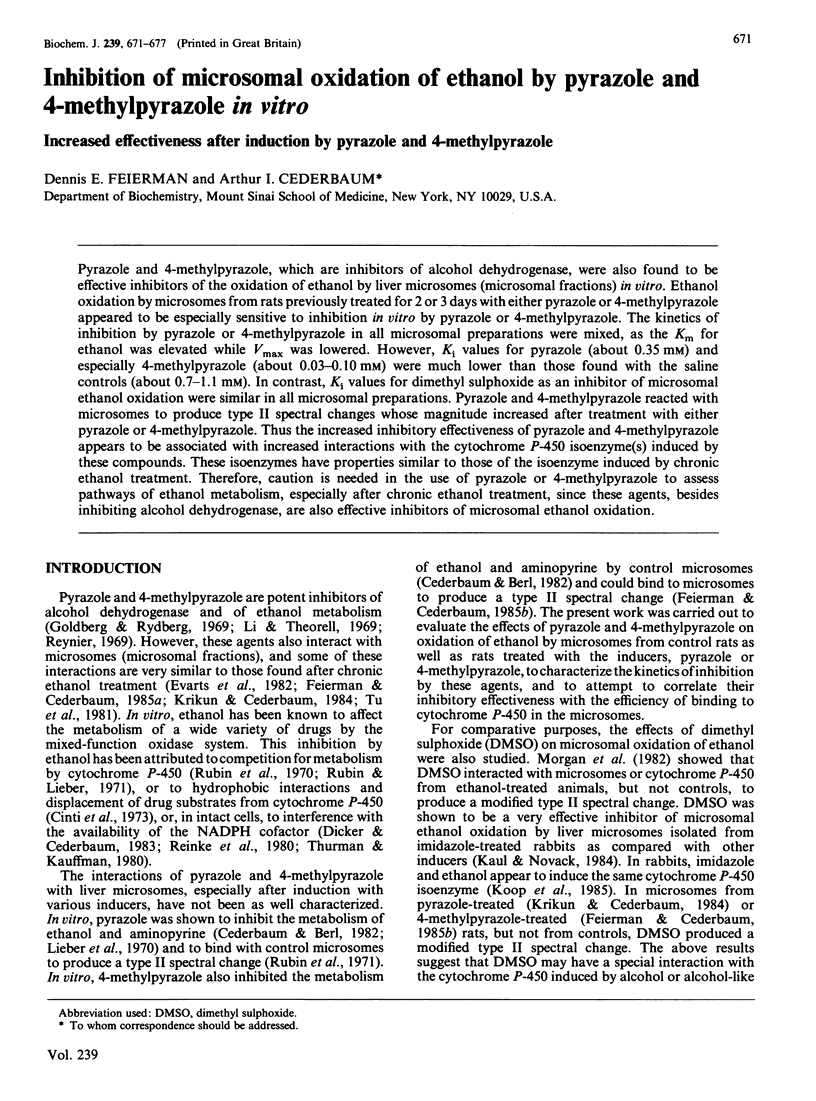
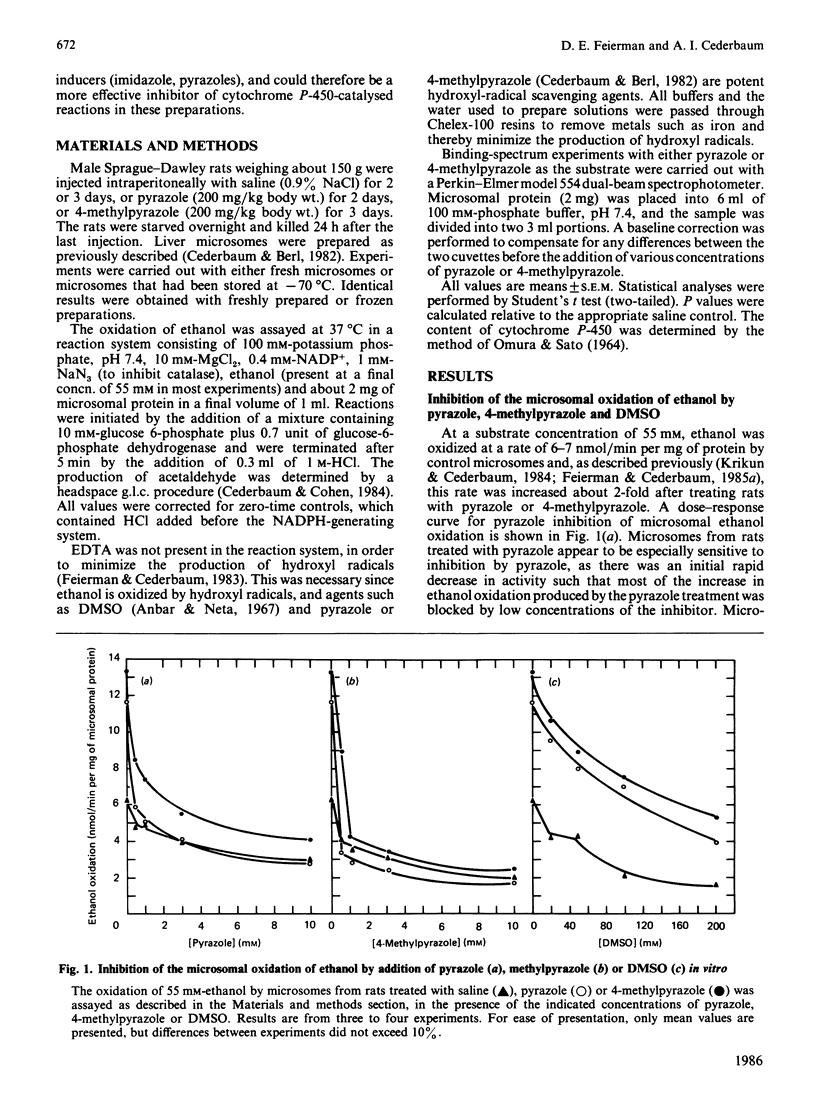
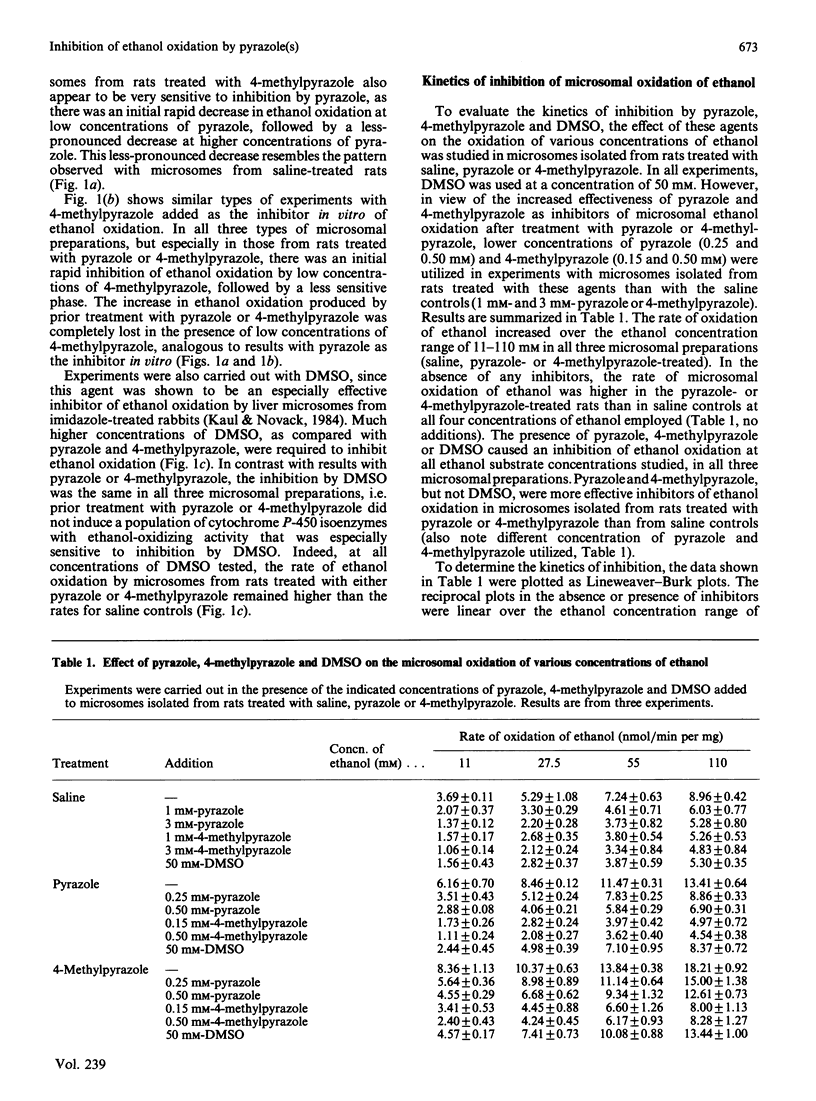
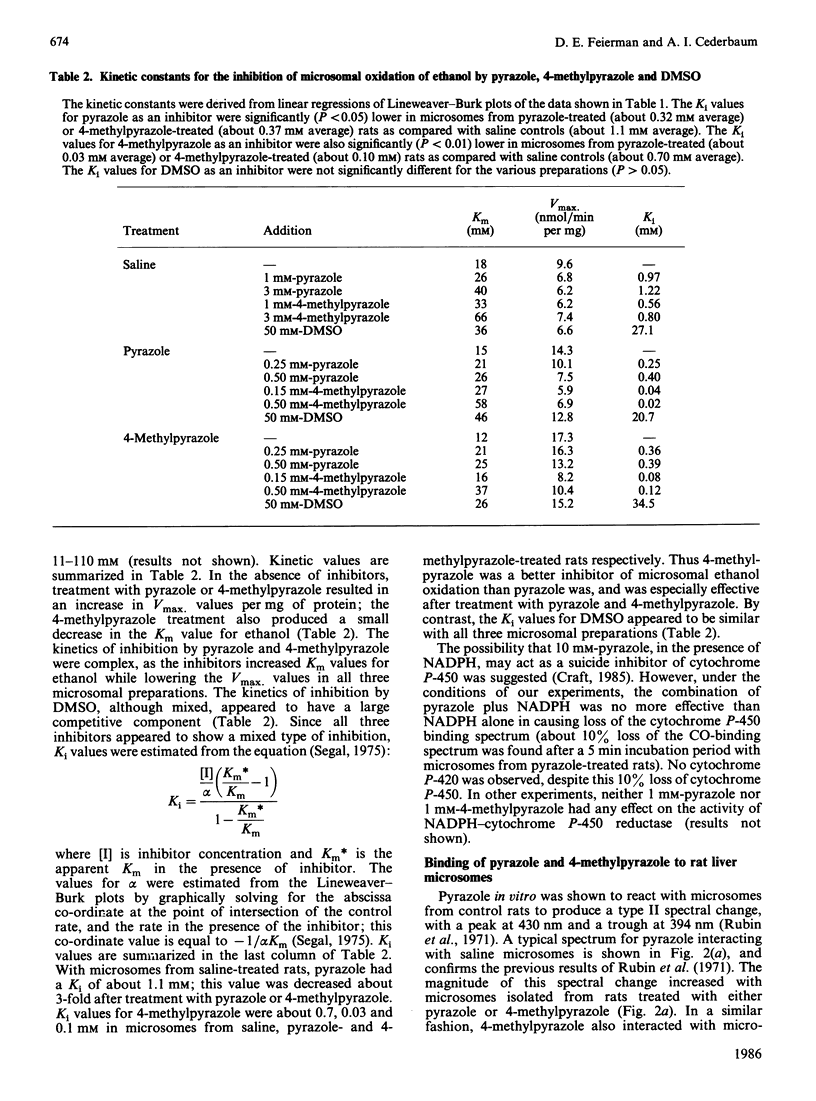
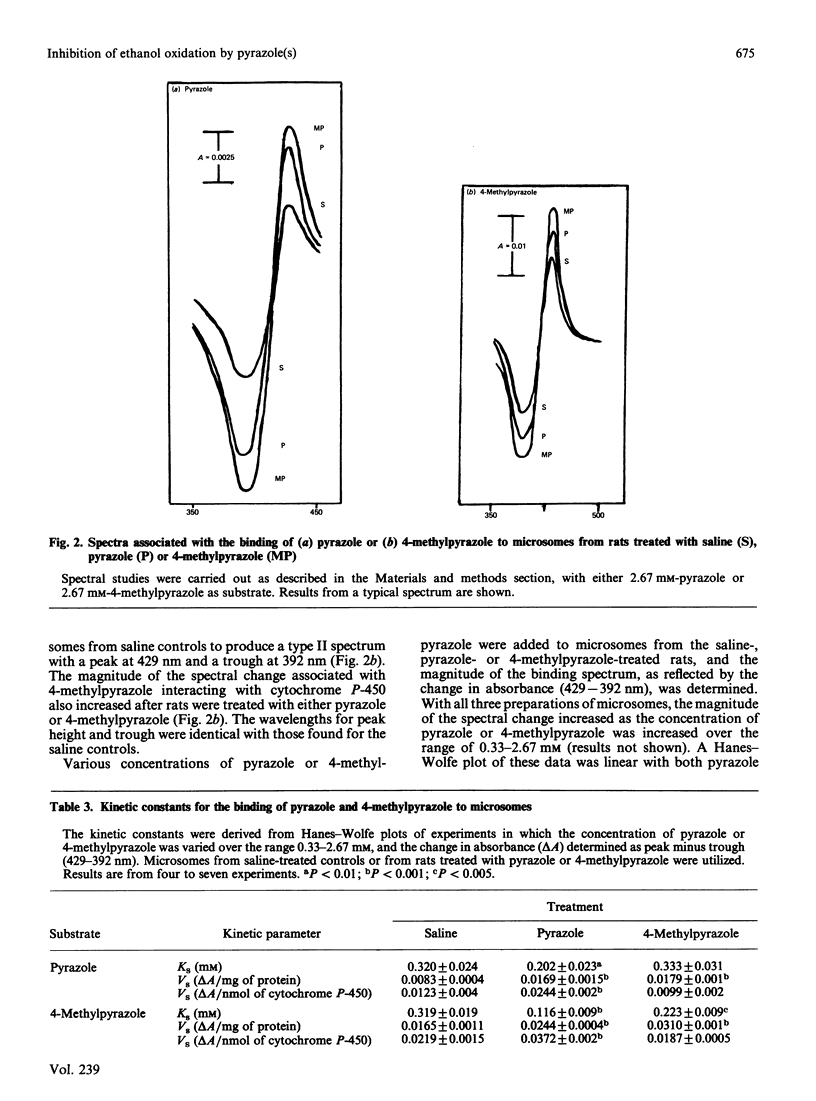
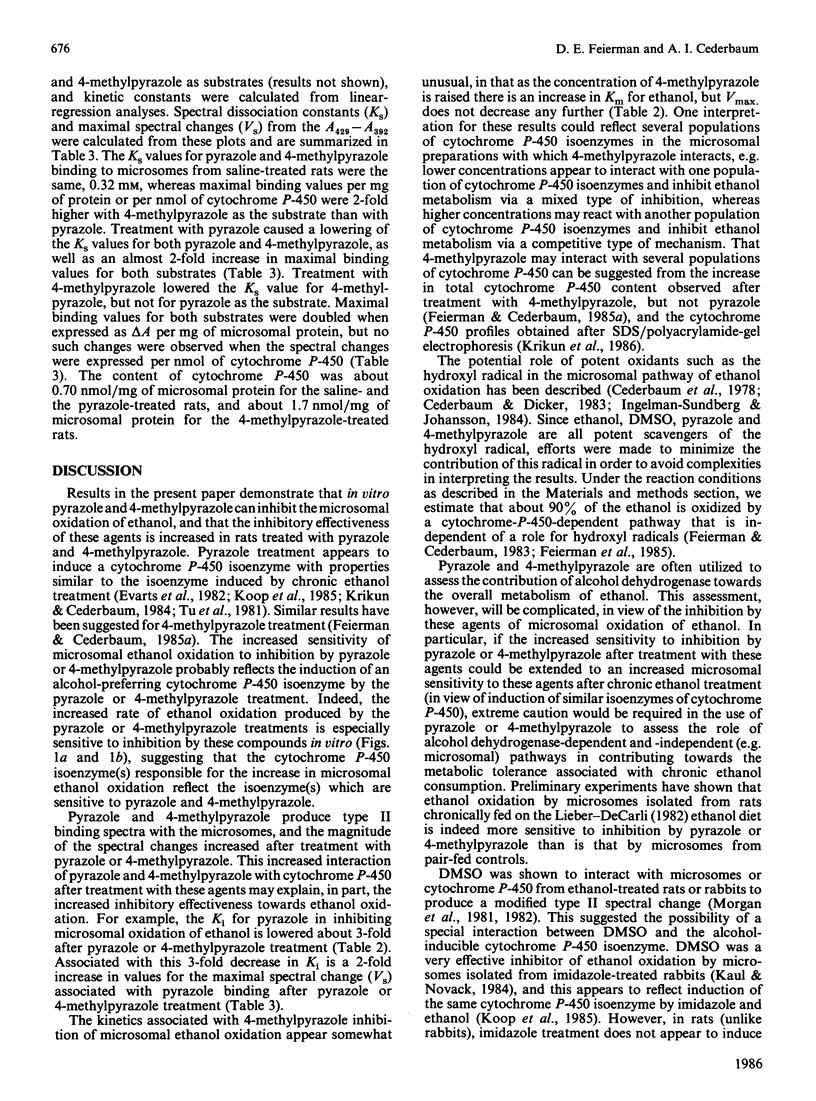
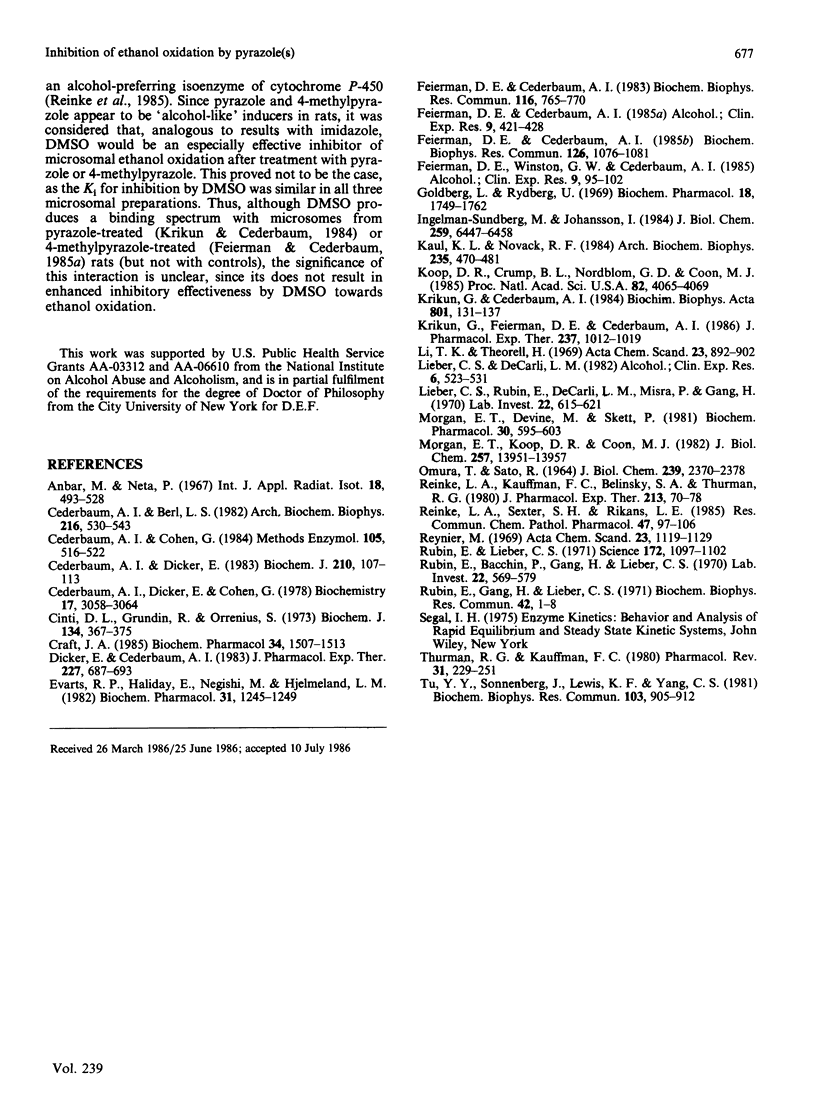
Selected References
These references are in PubMed. This may not be the complete list of references from this article.
- Cederbaum A. I., Berl L. Pyrazole and 4-methylpyrazole inhibit oxidation of ethanol and dimethyl sulfoxide by hydroxyl radicals generated from ascorbate, xanthine oxidase, and rat liver microsomes. Arch Biochem Biophys. 1982 Jul;216(2):530–543. doi: 10.1016/0003-9861(82)90242-9. [DOI] [PubMed] [Google Scholar]
- Cederbaum A. I., Cohen G. Microsomal oxidant radical production and ethanol oxidation. Methods Enzymol. 1984;105:516–522. doi: 10.1016/s0076-6879(84)05071-0. [DOI] [PubMed] [Google Scholar]
- Cederbaum A. I., Dicker E., Cohen G. Effect of hydroxyl radical scavengers on microsomal oxidation of alcohols and on associated microsomal reactions. Biochemistry. 1978 Jul 25;17(15):3058–3064. doi: 10.1021/bi00608a018. [DOI] [PubMed] [Google Scholar]
- Cederbaum A. I., Dicker E. Inhibition of microsomal oxidation of alcohols and of hydroxyl-radical-scavenging agents by the iron-chelating agent desferrioxamine. Biochem J. 1983 Jan 15;210(1):107–113. doi: 10.1042/bj2100107. [DOI] [PMC free article] [PubMed] [Google Scholar]
- Cinti D. L., Grundin R., Orrenius S. The effect of ethanol on drug oxidations in vitro and the significance of ethanol-cytochrome P-450 interaction. Biochem J. 1973 Jun;134(2):367–375. doi: 10.1042/bj1340367. [DOI] [PMC free article] [PubMed] [Google Scholar]
- Craft J. A. Effects of pyrazole on nitrosodimethylamine demethylase and other microsomal xenobiotic metabolising activities. Biochem Pharmacol. 1985 May 1;34(9):1507–1513. doi: 10.1016/0006-2952(85)90692-6. [DOI] [PubMed] [Google Scholar]
- Dicker E., Cederbaum A. I. Effect of ethanol and metabolic substrates on the oxidation of aminopyrine, formaldehyde and formate by isolated hepatocytes. J Pharmacol Exp Ther. 1983 Dec;227(3):687–693. [PubMed] [Google Scholar]
- Evarts R. P., Haliday E., Negishi M., Hjelmeland L. M. Induction of microsomal dimethylnitrosamine demethylase by pyrazole. Biochem Pharmacol. 1982 Apr 1;31(7):1245–1249. doi: 10.1016/0006-2952(82)90011-9. [DOI] [PubMed] [Google Scholar]
- Feierman D. E., Cederbaum A. I. Increased content of cytochrome P-450 and 4-methylpyrazole binding spectrum after 4-methylpyrazole treatment. Biochem Biophys Res Commun. 1985 Feb 15;126(3):1076–1081. doi: 10.1016/0006-291x(85)90295-5. [DOI] [PubMed] [Google Scholar]
- Feierman D. E., Cederbaum A. I. Interaction of pyrazole and 4-methylpyrazole with hepatic microsomes: effect on cytochrome P-450 content, microsomal oxidation of alcohols, and binding spectra. Alcohol Clin Exp Res. 1985 Sep-Oct;9(5):421–428. doi: 10.1111/j.1530-0277.1985.tb05576.x. [DOI] [PubMed] [Google Scholar]
- Feierman D. E., Cederbaum A. I. The effect of EDTA and iron on the oxidation of hydroxyl radical scavenging agents and ethanol by rat liver microsomes. Biochem Biophys Res Commun. 1983 Oct 31;116(2):765–770. doi: 10.1016/0006-291x(83)90590-9. [DOI] [PubMed] [Google Scholar]
- Feierman D. E., Winston G. W., Cederbaum A. I. Ethanol oxidation by hydroxyl radicals: role of iron chelates, superoxide, and hydrogen peroxide. Alcohol Clin Exp Res. 1985 Mar-Apr;9(2):95–102. doi: 10.1111/j.1530-0277.1985.tb05525.x. [DOI] [PubMed] [Google Scholar]
- Goldberg L., Rydberg U. Inhibition of ethanol metabolism in vivo by administration of pyrazole. Biochem Pharmacol. 1969 Jul;18(7):1749–1762. doi: 10.1016/0006-2952(69)90164-6. [DOI] [PubMed] [Google Scholar]
- Ingelman-Sundberg M., Johansson I. Mechanisms of hydroxyl radical formation and ethanol oxidation by ethanol-inducible and other forms of rabbit liver microsomal cytochromes P-450. J Biol Chem. 1984 May 25;259(10):6447–6458. [PubMed] [Google Scholar]
- Kaul K. L., Novak R. F. Induction of rabbit hepatic microsomal cytochrome P-450 by imidazole: enhanced metabolic activity and altered substrate specificity. Arch Biochem Biophys. 1984 Dec;235(2):470–481. doi: 10.1016/0003-9861(84)90220-0. [DOI] [PubMed] [Google Scholar]
- Koop D. R., Crump B. L., Nordblom G. D., Coon M. J. Immunochemical evidence for induction of the alcohol-oxidizing cytochrome P-450 of rabbit liver microsomes by diverse agents: ethanol, imidazole, trichloroethylene, acetone, pyrazole, and isoniazid. Proc Natl Acad Sci U S A. 1985 Jun;82(12):4065–4069. doi: 10.1073/pnas.82.12.4065. [DOI] [PMC free article] [PubMed] [Google Scholar]
- Krikun G., Cederbaum A. I. Increased microsomal oxidation of alcohols after pyrazole treatment and its similarities to the induction by ethanol consumption. Biochim Biophys Acta. 1984 Sep 7;801(1):131–137. doi: 10.1016/0304-4165(84)90221-6. [DOI] [PubMed] [Google Scholar]
- Krikun G., Feierman D. E., Cederbaum A. I. Rat liver microsomal induction of the oxidation of drugs and alcohols, and sodium dodecyl sulfate-gel profiles after in vivo treatment with pyrazole or 4-methylpyrazole. J Pharmacol Exp Ther. 1986 Jun;237(3):1012–1019. [PubMed] [Google Scholar]
- Li T. K., Theorell H. Human liver alcohol dehydrogenase: inhibition by pyrazole and pyrazole analogs. Acta Chem Scand. 1969;23(3):892–902. doi: 10.3891/acta.chem.scand.23-0892. [DOI] [PubMed] [Google Scholar]
- Lieber C. S., DeCarli L. M. The feeding of alcohol in liquid diets: two decades of applications and 1982 update. Alcohol Clin Exp Res. 1982 Fall;6(4):523–531. doi: 10.1111/j.1530-0277.1982.tb05017.x. [DOI] [PubMed] [Google Scholar]
- Lieber C. S., Rubin E., DeCarli L. M., Misra P., Gang H. Effects of pyrazole on hepatic function and structure. Lab Invest. 1970 Jun;22(6):615–621. [PubMed] [Google Scholar]
- Morgan E. T., Devine M., Skett P. Changes in the rat hepatic mixed function oxidase system associated with chronic ethanol vapor inhalation. Biochem Pharmacol. 1981 Mar 15;30(6):595–600. doi: 10.1016/0006-2952(81)90131-3. [DOI] [PubMed] [Google Scholar]
- Morgan E. T., Koop D. R., Coon M. J. Catalytic activity of cytochrome P-450 isozyme 3a isolated from liver microsomes of ethanol-treated rabbits. Oxidation of alcohols. J Biol Chem. 1982 Dec 10;257(23):13951–13957. [PubMed] [Google Scholar]
- OMURA T., SATO R. THE CARBON MONOXIDE-BINDING PIGMENT OF LIVER MICROSOMES. I. EVIDENCE FOR ITS HEMOPROTEIN NATURE. J Biol Chem. 1964 Jul;239:2370–2378. [PubMed] [Google Scholar]
- Reinke L. A., Kauffman F. C., Belinsky S. A., Thurman R. G. Interactions between ethanol metabolism and mixed-function oxidation in perfused rat liver: inhibition of p-nitroanisole O-demethylation. J Pharmacol Exp Ther. 1980 Apr;213(1):70–78. [PubMed] [Google Scholar]
- Reinke L. A., Sexter S. H., Rikans L. E. Comparison of ethanol and imidazole pretreatments on hepatic monooxygenase activities in the rat. Res Commun Chem Pathol Pharmacol. 1985 Jan;47(1):97–106. [PubMed] [Google Scholar]
- Reynier M. Pyrazole inhibition and kinetic studies of ethanol and retinol oxidation catalyzed by rat liver alcohol dehydrogenase. Acta Chem Scand. 1969;23(4):1119–1129. doi: 10.3891/acta.chem.scand.23-1119. [DOI] [PubMed] [Google Scholar]
- Rubin E., Bacchin P., Gang H., Lieber C. S. Induction and inhibition of hepatic microsomal and mitochondrial enzymes by ethanol. Lab Invest. 1970 Jun;22(6):569–580. [PubMed] [Google Scholar]
- Rubin E., Gang H., Lieber C. S. Interaction of ethanol and pyrazole with hepatic microsomes. Biochem Biophys Res Commun. 1971 Jan 8;42(1):1–8. doi: 10.1016/0006-291x(71)90353-6. [DOI] [PubMed] [Google Scholar]
- Rubin E., Lieber C. S. Alcoholism, alcohol, and drugs. Science. 1971 Jun 11;172(3988):1097–1102. doi: 10.1126/science.172.3988.1097. [DOI] [PubMed] [Google Scholar]
- Thurman R. G., Kauffman F. C. Factors regulating drug metabolism in intact hepatocytes. Pharmacol Rev. 1979 Dec;31(4):229–251. [PubMed] [Google Scholar]
- Tu Y. Y., Sonnenberg J., Lewis K. F., Yang C. S. Pyrazole-induced cytochrome P-450 in rat liver microsomes: an isozyme with high affinity for dimethylnitrosamine. Biochem Biophys Res Commun. 1981 Dec 15;103(3):905–912. doi: 10.1016/0006-291x(81)90896-2. [DOI] [PubMed] [Google Scholar]


